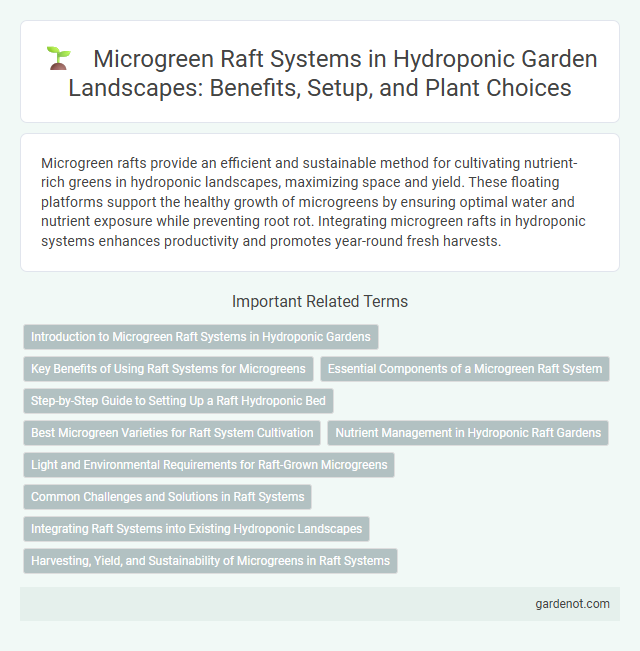Microgreen rafts provide an efficient and sustainable method for cultivating nutrient-rich greens in hydroponic landscapes, maximizing space and yield. These floating platforms support the healthy growth of microgreens by ensuring optimal water and nutrient exposure while preventing root rot. Integrating microgreen rafts in hydroponic systems enhances productivity and promotes year-round fresh harvests.
Introduction to Microgreen Raft Systems in Hydroponic Gardens
Microgreen raft systems in hydroponic gardens utilize floating platforms to grow dense, nutrient-rich microgreens without soil, optimizing space and water use efficiency. These systems provide controlled environments that enhance growth rates by delivering oxygenated nutrient solutions directly to the roots. Popular in commercial and urban farming, microgreen rafts improve yield uniformity and reduce contamination risks compared to traditional cultivation methods.
Key Benefits of Using Raft Systems for Microgreens
Raft systems for microgreens provide superior water and nutrient efficiency, ensuring consistent hydration and growth without soil dependency. These systems promote faster germination and uniform root development by maintaining optimal moisture levels, reducing the risk of diseases such as damping-off. Microgreen raft technology also allows for higher planting densities and easier automated harvesting, significantly improving productivity and reducing labor costs in hydroponic landscapes.
Essential Components of a Microgreen Raft System
A microgreen raft system relies on essential components such as buoyant foam boards that support seedlings, a water reservoir providing nutrient-rich solutions, and an aeration mechanism ensuring oxygen circulation to roots. The foam boards enable uniform plant spacing and stability while preventing roots from submerging too deeply, optimizing growth conditions. Consistent nutrient delivery combined with proper oxygenation enhances microgreen yield and quality in hydroponic cultivation.
Step-by-Step Guide to Setting Up a Raft Hydroponic Bed
Setting up a microgreen raft hydroponic bed begins with selecting a sturdy, waterproof container, such as a shallow tray, to serve as the base. Fill the tray with nutrient-rich water solution and position a floating raft made of foam or polystyrene with evenly spaced holes to hold microgreen seed trays. Ensure proper aeration and maintain water temperature between 65-75degF for optimal growth while regularly monitoring pH levels around 5.5 to 6.5 to promote healthy root development in the hydroponic system.
Best Microgreen Varieties for Raft System Cultivation
Kale, arugula, and sunflower are among the best microgreen varieties for raft system cultivation due to their vigorous growth and high nutrient content. These varieties thrive in hydroponic raft systems, which provide consistent water and nutrient delivery, maximizing yield and quality. Choosing robust microgreens with fast germination and strong roots enhances the efficiency and productivity of hydroponic raft landscapes.
Nutrient Management in Hydroponic Raft Gardens
Hydroponic raft gardens utilize precise nutrient management to optimize microgreen growth by continuously circulating nutrient-rich water over the root systems. Maintaining the ideal balance of macronutrients like nitrogen, phosphorus, and potassium along with micronutrients ensures vigorous germination and nutrient density in microgreens. Automated monitoring systems enable real-time adjustments of pH and electrical conductivity, preventing nutrient lockout and promoting sustainable hydroponic production.
Light and Environmental Requirements for Raft-Grown Microgreens
Raft-grown microgreens require consistent exposure to 12-16 hours of full-spectrum LED or fluorescent light to promote optimal photosynthesis and nutrient density. Maintaining temperature between 65-75degF and humidity around 50-70% minimizes fungal growth and ensures vigorous leaf development. Proper ventilation and clean water with balanced pH (5.5-6.5) further enhance growth rate and yield in hydroponic raft systems.
Common Challenges and Solutions in Raft Systems
Microgreen raft systems often face challenges such as waterborne diseases, nutrient imbalances, and root oxygenation issues that can stunt growth and reduce yield. Implementing proper water filtration, adjusting nutrient solution concentrations, and aerating the root zone can effectively mitigate these problems. Regular monitoring and maintenance are crucial to ensure optimal environmental conditions for healthy microgreen development in hydroponic raft setups.
Integrating Raft Systems into Existing Hydroponic Landscapes
Integrating microgreen raft systems into existing hydroponic landscapes enhances crop density and optimizes space utilization by allowing simultaneous growth of diverse plants. The floating rafts provide consistent moisture and nutrient delivery, reducing labor and improving yield quality in controlled environments. Efficient water circulation and aeration within raft systems promote root health, accelerating microgreen production cycles and maximizing resource efficiency.
Harvesting, Yield, and Sustainability of Microgreens in Raft Systems
Microgreen raft systems enable efficient harvesting by allowing uniform growth and easy removal of mature greens, maximizing yield per square foot with consistent nutrient delivery. These systems enhance sustainability through reduced water usage, minimized soil waste, and decreased need for pesticides, promoting an eco-friendly cultivation method. High-density planting in hydroponic rafts optimizes space and accelerates growth cycles, supporting year-round production of nutrient-rich microgreens.
Microgreen raft Infographic

 gardenot.com
gardenot.com